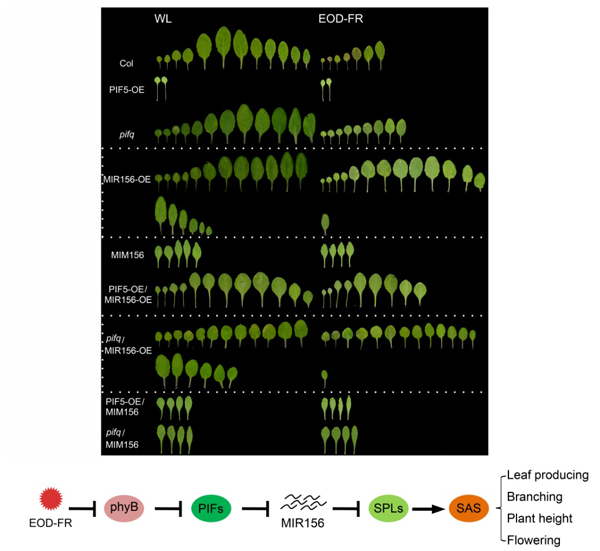With the ever increasing world population, it is a daunting task to produce enough food, feed and fuel targeted bioproducts with limited resources. Over the past few decades, increasing planting density has been an effective way of improving crop yields per unit land area. However, a key factor that limits planting density in modern agricultural practice is the plant’s shade avoidance response, which is triggered when plants sense a reduction of red (R) to far-red (FR) light ratios (R:FR) in their environment due to absorption of R light by neighboring plants. Typical shade avoidance responses include increased plant height, elevated leaf angles to horizontal, reduced branching, decreased leaf blade area and early flowering. Collectively, these traits are termed shade avoidance syndrome (SAS). For crop species, the SAS could lead to reduced yields due to reduced investment of resources on reproductive development and decreased immunity to plant pests and pathogens. Thus, it is highly desirable to breed crops with attenuated SAS.
Previous studies have shown that in higher plants, SAS is primarily mediated by the red/far-red light photoreceptor phytochromes. However, the detailed molecular mechanism by which phytochromes regulate SAS has remained unclear. In a recent study headed by Professor Haiyang Wang of Biotechnology Research Institute, Chinese Academy of Agricultural Sciences, a group of scientists showed that in the model species Arabidopsis thaliana, simulated shade represses phytochrome activity, leading to rapid accumulation of PIF proteins (a group of phytochrome-intercating factors). These PIF proteins act as transcription factors and directly bind to the promoters of several MIR156 genes and repress their expression, accompanied by a concomitant increase in the expression of SQUAMOSA-PROMOTER BINDING PROTEIN-LIKE (SPL) family of transcription factors. In turn, the SPL transcription factors act to regulate various aspects of SAS, including elongation of stem and petiole, leaf production, branching and flowering. These results, for the first time, provide a direct link between the phytochrome-PIFs and miR156-SPL regulatory modules in mediating SAS during plant vegetative growth and development, and thus have important implications for breeding shade-tolerant crops for tomorrow’s agriculture.
Associate Professor Yurong Xie and Dr. Yang Liu of Biotechnology Research Institute, Chinese Academy of Agricultural Sciences are co-first authors of this study. This work is supported by National Science Foundation of China and Beijing Municipal Natural Science Foundation.
article link:https://www.nature.com/articles/s41467-017-00404-y

|